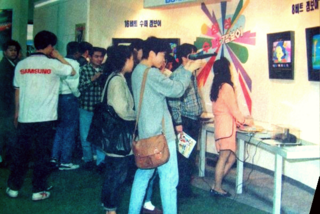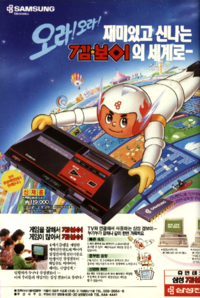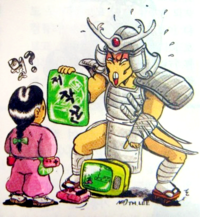Difference between revisions of "History of Sega in South Korea"
From Sega Retro
(→Today) |
|||
| Line 50: | Line 50: | ||
==Today== | ==Today== | ||
| − | Since 2003, [[Sega Publishing Korea]] is the representative of Sega in South Korea. | + | Since 2003, [[Sega Publishing Korea]] is the representative of Sega in South Korea. |
| + | |||
| + | In 2013, [[Shanda Games]] released [[Chain Chronicles]]<ref>https://www.techinasia.com/sega-hopes-to-take-chain-chronicles-across-asia-via-an-unexpected-partner</ref> | ||
| + | |||
| + | In 2010s, Sega created Sega Asia which handle regional releases of games.<ref>https://www.siliconera.com/sega-established-singapore-branch-to-cover-southeast-asia/</ref> | ||
==External links== | ==External links== | ||
Revision as of 16:52, 20 November 2022

|
| History of Sega in South Korea |
|---|
| Official Sega distributor(s): Korea OACS (198x-198x), Samsung (198x-1997), Kama Entertainment (1997-1998), Korea Data Systems (1997-1998), Hyundai-Sega Entertainment (1996-2000), SKC (199x-1998), Wizard Soft (1999-2005), Sonokong (200x-200x), Sega Korea (2003-present) |
This teeny-tiny article needs some work. You can help us by expanding it.
South Korea has and continues to see a number of Sega products imported into the country, in addition to producing its own hardware and software for Sega systems.
Contents
Background
Arcade era
MSX compatibles
Korean OACS
Korea OACS were responsible for the official distribution of the Sega Mark III.
Samsung
Sega Master System era

Most of Sega's home consoles were distributed in South Korea by Samsung. The names were changed because the Japanese products were illegal in this region and thats why the Sega Master System was sold as Gam * Boy (later as Aladdin Boy).
Sega Mega Drive era
Sega Mega Drive was sold as Super Gam * Boy (later as Super Aladdin Boy), Sega Mega CD as CD Aladdin Boy, Sega Game Gear as Handy Gam * Boy and Sega 32X as Super 32X.
In 1994, Sega Digital Communications announced the launch of Sega Channel within a year, however, it is not known today whether this happened.
Sega Saturn era
Sega Saturn was sold as Samsung Saturn. In February 1997, after poor Saturn sales, Samsung exited the gaming business.
Kama Entertainment
In September 1997, Sega Saturn returned this time under its original name. The distributor was Kama Entertainment and Korea Data Systems. Both companies also brought Sega Mega Drive under the original name. Wooyoung System translated games into Korean. Some of the games released by Samsung have been released for the second time.
HiCom
Around 1997, HiCom also imported and distributed the Sega Mega Drive 2 in South Korea, under that name. The label on the bottom of the console says the model number is "MK-1631-08" (08 being the country code for South Korea). It also says SEGA ENTERPRISES, LTD." and "MADE IN CHINA". It is unknown if the label is the original label, as the console may have been a grey market (parallel) import with new (replaced) labels.
Hyundai
In 1996 Sega formed a partnership with Hyundai, creating Hyundai-Sega Entertainment to bring arcade games and components to the country. The move was expected to produce $25 million USD in revenue for the two companies[1].
Soon, Hyundai decided to release Sega games on PC. In 1998, the company announced that it will become the distributor of the new Sega Dreamcast console. In late 1999, it was promised that the console would be available in early 2000 but the system was still not released. In May 2000, it was decided that the consoles will be imported in unchanged Japanese version. 25,000 units were sent to Korea before Hyundai broke cooperation with Sega in September 2000. It is unknown if someone later sold Dreamcast in Korea.[2]
PC era
Companies that distributed some Sega computer games:
Today
Since 2003, Sega Publishing Korea is the representative of Sega in South Korea.
In 2013, Shanda Games released Chain Chronicles[4]
In 2010s, Sega created Sega Asia which handle regional releases of games.[5]
External links
- A History of Korean Gaming article by Sam Derboo at Hardcore Gaming 101
References
- ↑ Ultra Game Players, "March 1997" (US; 1997-02-25), page 16
- ↑ http://www.hardcoregaming101.net/korea/part2/korea2.htm
- ↑ https://web.archive.org/web/20010407222202/http://wzsoft.com:80/english/pd.html
- ↑ https://www.techinasia.com/sega-hopes-to-take-chain-chronicles-across-asia-via-an-unexpected-partner
- ↑ https://www.siliconera.com/sega-established-singapore-branch-to-cover-southeast-asia/
